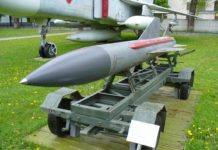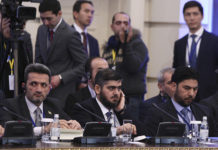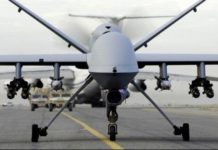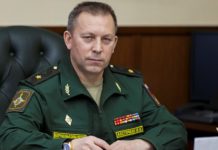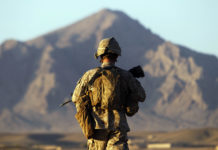Anton Baev, Polina Khimshiashvili
RBC, August 17, 2016, p. 6
Russian strategic bombers Tu-22M3 will be based at Iranian air base Hamadan.
IRAN PROVIDED MILITARY AIRFIELD HAMADAN FOR RUSSIAN LONG-RANGE AVIATION
The Defense Ministry of Russia stationed Tu-22 in Iran having asked Iran and Iraq for permission to use their airspace for flights of missiles. These measures have to increase intensity of bombing and change the situation in Aleppo.
Russian strategic bombers Tu-22M3 arrived to Iranian air base Hamadan on Monday afternoon, Al-Masdar News reported. On Tuesday, August 16, the airplanes performed the first sortie. According to the Defense Ministry, aviation strikes were delivered at positions of Islamic State and Jabhat al-Nusra (in July it was renamed into Jabhat Fatah al-Sham, both groups are prohibited in Russia) in Aleppo, Deir ez-Zor and Idlib provinces. The precise quantity of the bombers moved to Iran and duration of their stay there are not known.
Earlier, a military diplomatic source reported to Interfax that the Defense Ministry sent a query to Iran and Iraq for use of airspace of both countries. According to the source, Russian military are going to use the permit of Baghdad and Tehran for launches of cruise missiles.
According to President of the International Center of Geopolitical Analysis Leonid Ivashov, launches of tactical cruise missiles Kalibr formerly performed from submarines and ships in the Caspian Sea were also coordinated with Tehran. Ivashov presumed, “These were queries in a secret mode with limitation in time and altitude.” The expert presumes that the new agreement will enable the Russian troops to use cruise missiles on the permanent basis.
Russian strategic bombers Tu-22M3 are used in Syria since autumn of 2015. However, frequency of their sorties was not big and did not exceed 25 sorties per week. The departure airfield was in Mozdok in North Ossetia, 2,000 kilometers from the place of dropping of the bombs. Frontline bombers Su-24 were used much more actively to date.
Military analyst Anton Lavrov presumes that relocation of Tu-22M3 to Hamadan base will allow reduction of the time of flight and taking of twice as much projectiles. The expert explains, “Su-24 are not as efficient, they can carry fewer bombs at a shorter distance.” Su-24 can drop about 7 tons of bombs in one sortie. The radius of the bomber’s use is 560 kilometers. Tu-22M3 has bigger capabilities. At a distance of up to 2,000 kilometers the strategic bomber can carry 12 tons of missiles and bombs of various types. The distance from Hamadan to Aleppo is smaller than 1,000 kilometers.
Alexander Khramchikhin, deputy director of the Institute of Political and Military Analysis, estimates creation of the additional bridgehead to the east of Syria (only the base in Latakia in the northwest of Syria was used until recently) and use of strategic bombers saying, “This is a correct decision that allows increasing of intensity and efficiency of bombing of the enemy.”
Gumer Isaev, director of the St. Petersburg-based Center for Studying of Modern Middle East, disagrees with him. Isaev says, “It is not quite clear how efficiently strategic aviation combats Islamic State.” According to him, use of expensive bombs and cruise missiles against a decentralized enemy is not logical. The expert says, “This is an occasion to demonstrate capabilities of our strategic aviation and army. Relocation of Tu-22 and use of missiles are relatively inexpensive but impressive measures.”
According to Director of the Center for Analysis of Strategies and Technologies Ruslan Pukhov, use of Tu-22 is not only demonstration of force but also a possibility to receive a real combat experience for pilots. Pukhov adds, “This is a real operation, real targets and new targets. For the Airspace Forces and pilots this is a unique opportunity to train in real conditions.”
The first strike delivered by the Tu-22M3 stationed in Iran was also delivered on Aleppo province where according to the Defense Ministry Jabhat al-Nusra group (prohibited in Russia) was located.
Military expert Victor Murakhovsky says that Tu-22M3 will not be used in the city. Murakhovsky explains, ‘Strategic aviation was used against bridges, communication nodes, staffs and command points.” According to him, use of Tu-22M3 within a city leads to serious destructions and victims.
Isaev remarked that formerly the Russian group of the Airspace Forces relied on strike helicopters Ka-52 and Mi-28N, as well as on attack airplanes SU-25. These types of aircraft helped the Syrian government in the phase of offensive. The Syrian operation transited to retention of the territory. Isaev presumes, “Aleppo is a perfect example in this aspect.”
Battle for Aleppo has been going on since 2012. Free Syrian Army, militants of Jabhat al-Nusra and other insurgent groups manage to keep eastern districts of the city. According to research fellow of the Institute of Oriental Studies of the Russian Academy of Sciences Grigory Melamedov, Aleppo allows controlling of approaches to the Turkish border. Before the war, 2.4 million people lived in Aleppo. Now this quantity decreased to 300,000.
In the last half a year, Syrian army conducted several operations for the purpose of closing of the ring around the rebels and blocking of the ways for supply of materiel and weapons both from the western part of Aleppo province and from Turkey. At the end of July, forces of Assad and allies managed to block eastern districts of the city but at the beginning of August Syrian opposition broke the blockade. The artillery school and hardware taken by Syrian insurgents enabled them to increase and to retain the corridor connecting the territories in the west of the province with the city blocks controlled by the rebels.
A week after attack of the rebels, Syrian army started a response operation. On Friday, August 12, troops of Lebanese party Hezbollah and Iraqi militia with support of artillery and multiple rocket launcher systems managed to narrow the corridor in four places but the attack was parried.
Iran was an ally of Damascus since the very beginning of the war in Syria and afterwards it was an ally of Moscow. The countries created the first information center in Baghdad. The latest visit of Defense Minister Sergei Shoigu to Iran took place in June. According to Deputy Defense Minister Anatoly Antonov, Shoigu discussed with Iranian and Syrian partners “priority measures for increase of interaction of the defense ministries in the struggle against the terrorist groups of Islamic State and Jabhat al-Nusra prohibited in Russia. A meeting of President Vladimir Putin with his Iranian colleague Hassan Rouhani took place in Baku on August 8. According to representatives of the Iranian party, the situation in Syria was among the discussed issues.
Observer of The New York Times Neil MacFarquhar is convinced that the agreement on use of the Iranian air base strengthens the military positions of Russia in the region seriously and thus may turn the Kremlin into the main intermediary of “any upcoming peace agreement on Syria.”
However, Russian experts presume that Hamadan air base will hardly become the second Hmeymim. Isaev states, “Unlike Syria, Iran is an independent state that plays its own game. I am not sure that agreements on Hamadan are long-term ones.” According to him, Russia and Iran has an existing alliance in the framework of the Syrian conflict but existing relations of Tehran with Western countries turn Russian bombers into an object of bargaining.







